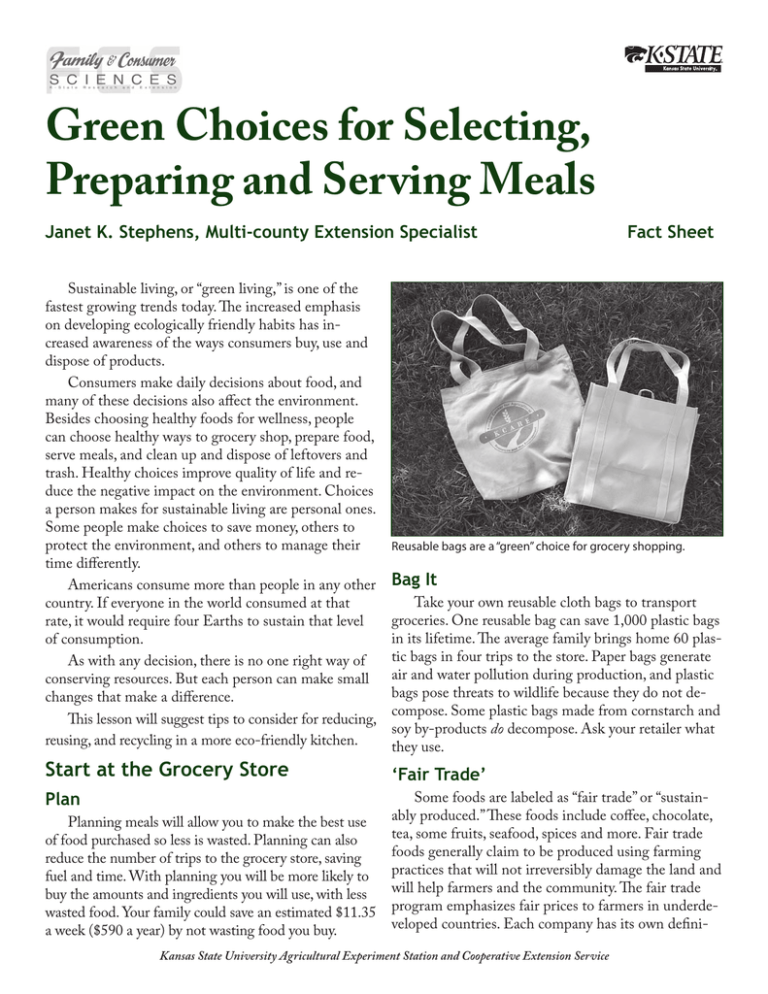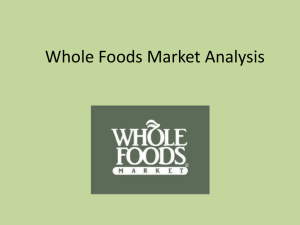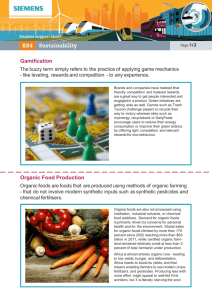Green Choices for Selecting, Preparing and Serving Meals Fact Sheet
advertisement

Green Choices for Selecting, Preparing and Serving Meals Janet K. Stephens, Multi-county Extension Specialist Sustainable living, or “green living,” is one of the fastest growing trends today. The increased emphasis on developing ecologically friendly habits has increased awareness of the ways consumers buy, use and dispose of products. Consumers make daily decisions about food, and many of these decisions also affect the environment. Besides choosing healthy foods for wellness, people can choose healthy ways to grocery shop, prepare food, serve meals, and clean up and dispose of leftovers and trash. Healthy choices improve quality of life and reduce the negative impact on the environment. Choices a person makes for sustainable living are personal ones. Some people make choices to save money, others to protect the environment, and others to manage their time differently. Americans consume more than people in any other country. If everyone in the world consumed at that rate, it would require four Earths to sustain that level of consumption. As with any decision, there is no one right way of conserving resources. But each person can make small changes that make a difference. This lesson will suggest tips to consider for reducing, reusing, and recycling in a more eco-friendly kitchen. Start at the Grocery Store Plan Planning meals will allow you to make the best use of food purchased so less is wasted. Planning can also reduce the number of trips to the grocery store, saving fuel and time. With planning you will be more likely to buy the amounts and ingredients you will use, with less wasted food. Your family could save an estimated $11.35 a week ($590 a year) by not wasting food you buy. Fact Sheet Reusable bags are a “green” choice for grocery shopping. Bag It Take your own reusable cloth bags to transport groceries. One reusable bag can save 1,000 plastic bags in its lifetime. The average family brings home 60 plastic bags in four trips to the store. Paper bags generate air and water pollution during production, and plastic bags pose threats to wildlife because they do not decompose. Some plastic bags made from cornstarch and soy by-products do decompose. Ask your retailer what they use. ‘Fair Trade’ Some foods are labeled as “fair trade” or “sustainably produced.” These foods include coffee, chocolate, tea, some fruits, seafood, spices and more. Fair trade foods generally claim to be produced using farming practices that will not irreversibly damage the land and will help farmers and the community. The fair trade program emphasizes fair prices to farmers in underdeveloped countries. Each company has its own defini- Kansas State University Agricultural Experiment Station and Cooperative Extension Service tion of “fair trade.” A company’s Web site may contain information to help define its claim. Reduce Packaging Many products come with excess packaging. A general guideline is: If there is more packaging than product, make another choice. • Choose products with minimal or no packaging (such as bulk products). Food in large containers can be repackaged into smaller reusable containers. Buy concentrated forms of a product (such as juice or laundry soap). • Buy eggs in cardboard cartons rather than foam. • Resist buying packaged single-serving items such as boxed juices that come with straws: the layers of paper, plastic, foil and wax make them completely non-recyclable. • Packaging made from one material is easier to recycle. Buy products packaged in recycled and recyclable cardboard. Choose your own vegetables without packaging at farmers markets or the grocery store. does not contain synthetic or artificial ingredients that would not normally be expected to be in the food – including artificial flavors or color additives, regardless of source. The label should explain what “natural” means in the product. “Natural” does not define whether a food is more or less healthy or safe to consume. Another term consumers may find confusing is “organic,” which refers to the way a food is grown and processed. The United States Department of Agriculture (USDA) says foods labeled “organic” must come from certified organic farms that use only approved organic pesticides and fertilizers. Synthetic pesticides and fertilizers, growth hormones, or antibiotics are not to be used. Organic food cannot be genetically modified. When processed, artificial ingredients, preservatives or irradiation cannot be used. The USDA sets requirements for organic claims and labels, but such labeling is voluntary, so not all organic products contain the USDA’s seal. If the seal is used, these claims must be met: • “100 percent organic” means the product contains only organic ingredients. • “Organic” products contain at least 95 percent organic ingredients (except for water and salt). • “Made with organic ingredients” indicates a product contains at least 70 percent organic ingredients. The USDA makes no claims that organic products are more nutritious, taste better or are safer than conventionally grown food. For those who want to go organic but may not have the budget to buy only organic food, consider choosing organically grown produce, such as apples, bell peppers, celery, cherries, imported grapes, nectarines, peaches, pears, potatoes, Buy Locally Buying foods produced close to where you live reduces the amount of transportation needed to ship the food, thus lowering food costs and fuel use. The average grocery store meal travels 1,300 miles to get to your table. In the Midwest, fresh fruits and vegetables are not always available locally, especially in the winter. For those choices, you may decide that “local” means grown in the United States. If your community has a farmers market in the growing season, consider the opportunity to shop locally, meet the grower, and ask how the food was produced. Locally produced bread, meat, and dairy products are often available year-round. “Locally produced” might also mean growing your own. Gardening can be a rewarding and enjoyable activity for your family. You will be able to decide what produce to grow and what gardening practices to use. Fresh produce, harvested at the right time, has a longer shelf life, can be more nutritious, and tastes great. K-State Research and Extension has information about freezing or canning the excess from your garden. Natural or Organic? The term “natural” is on many food packages but the Food and Drug Administration (FDA) has not established regulations for using the term. Policy regarding the use of “natural” generally means that the product 2 Serve the Meal red raspberries, spinach, and strawberries. (These fruits and vegetables, when grown conventionally, may contain pesticide and fertilizer residue.) Minimize the use of paper towels, paper plates, and napkins. Invest in cloth napkins for everyday use, and choose reusable cloths, towels, and plates, rather than paper throwaways. Purchase beverages in refillable bottles, or recyclable glass or plastics. If you use bottled water, buy in a larger bottle with several servings. When taking water with you, use a refillable water bottle instead of buying single-use bottles. Prepare the Meal Cook at Home At many fast-food restaurants, a single meal is not only high in fat, cholesterol, salt, and sugar, but also packaged in excess paper, foam, or plastic. In contrast, the “slow food” movement encourages people to enjoy food prepared and served in a less hurried manner and enjoyed for the experience. You’ll also save fuel by not driving to a restaurant. The Clean-up The average kitchen contributes more than 200 pounds Consider Available Equipment of waste each year. Think Think about the tools you need to prepare a meal. about how you can reduce that Choose your favorite ones to save and donate unused amount. Paper, plastic, and gadgets to thrift shops. Look around the secondhand aluminum account for 85 perstore for things you need instead of always buying new. cent of packaging materials, and most can be recycled. Use a smaller appliance when possible. For examCompost fruit and vegetable peels and pulp. (See ple, use a toaster oven for heating small things instead K-State Research and Extension bulletin Making and of the electric range. Using Compost at Home, MF-1053, for information on Save Water composting.) Wash dishes by hand when there isn’t a full Choose cleaning products that are the least toxic, dishwasher load. Don’t use the prewash cycle unless and don’t overuse a product. Use liquid detergents necessary and use the no-heat drying cycle. While to reduce the amount of heavy metals in wastewater. waiting for hot water in the faucet, fill the coffee pot Many manufacturers are developing products for a or watering can. Wash dishes or vegetables in a sink “green” line, with natural ingredients from plant matefull of water instead of under running water, then rials. rinse with running water. Read the instructions and use the product as directed. Use the entire cleaning product and take the Save Energy empty container to the recycling center. When purchasing new appliances for the kitchen, If you use “natural” cleaners, such as vinegar, table choose energy-efficient models. Even if they cost more, it is usually the wisest choice over the lifetime of salt, and lemon juice, remember that they are also chemicals and must be used safely. Do not mix chemithe appliance. The top energy user in the home (excals: the classic example is the mixture of chlorine cluding the central heating unit) is the water heater, bleach and ammonia, which creates a toxic gas. followed by refrigerator (No. 2), freezer (No. 3), range Consider buying garbage bags that are biodegrad(No. 5), and dishwasher (No. 8). The higher the appliable and compostable. ance is on the list, the more economical it will be the Find out about your community’s recycling serbuy the energy-efficient model. Energy Use labels on vices. Presort your recyclables at home and plan trips appliances can help compare models. to the center as you make another trip to the area. If Five percent of a home’s electricity is used to power electronics while they are turned off. This could curbside recycling is available, take advantage of it. If your community doesn’t have a recycling program, cost your family $50 a year. Unplug power cords when talk to city leaders, county commissioners, and other the appliances (such as cell phone chargers, radios, interested residents to help develop one. toasters, etc) are not in use. 3 Consider how you could reuse packaging products after careful cleaning. Wash towels, washcloths and cloth napkins in hot water to disinfect, but rinse with cold water. Line dry if possible. Remember: Choices should be a balance of your social, environmental, and economic values. Being conscious of what you eat, how you live, and what you buy can be a start to living in a more ecologically responsible manner. The daily decisions you make about food can make you and the environment healthier. By reviewing your choices you will better be able to understand the impact lifestyles have on individuals, families, communities, and the world. References: Living Sustainably: It’s Your Choice – Oregon State University American Moving and Storage Association 57 Ways to Protect Your Home Environment and Yourself - NC Regional Extension Publication 583 missourifamilies.org – Missouri University Extension Intentional Harmony program smartshopping.org – Consumer Reports Author Janet K. Stephens K-State Research and Extension Foods, Nutrition, Health & Safety Specialist Greenwood and Wilson counties Rolling Prairie Extension District jstephen@ksu.edu Greenwood County office - 311 N. Main, Eureka, KS 67045 (620-583-7455) Wilson County office - Courthouse, Rm. 101, Fredonia, KS 66736 (620-378-2167) Rolling Prairie District - Sedan office - Courthouse, Sedan, KS 67351 (620-725-5890) Rolling Prairie District - Howard office - P.O. Box 647, Howard, KS 67349 (620-374-2174) SE Area Extension, 308 W. 14th St., Chanute, KS 66720 (620-431-1530) Brand names appearing in this publication are for product identification purposes only. No endorsement is intended, nor is criticism implied of similar products not mentioned. Publications from Kansas State University are available on the World Wide Web at: www.ksre.ksu.edu Contents of this publication may be freely reproduced for educational purposes. All other rights reserved. In each case, credit Janet K. Stephens, Green Choices for Selecting, Preparing and Serving Meals, Fact Sheet, Kansas State University, August 2009. Kansas State University Agricultural Experiment Station and Cooperative Extension Service MF2883 August 2009 K-State Research and Extension is an equal opportunity provider and employer. Issued in furtherance of Cooperative Extension Work, Acts of May 8 and June 30, 1914, as amended. Kansas State University, County Extension Councils, Extension Districts, and United States Department of Agriculture Cooperating, Fred A. Cholick, Director.




